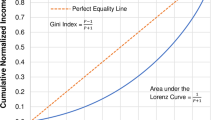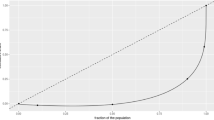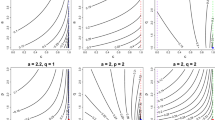Abstract
This paper proposes a single parameter functional form for the Lorenz curve and compares its performance with the existing single parameter functional forms using Australian income data for 10 years. The proposed parametric functional form performs better than the existing Lorenz functional specifications based on mean-squared error and information accuracy measure. The Gini based on the proposed functional form turns out to be second best closely behind Aggarwal’s Lorenz curve specification in each year.
Similar content being viewed by others
Avoid common mistakes on your manuscript.
1 Introduction
The Lorenz curves play an important role in the measurement and comparison of income inequality, tax progressivity and redistributive effects of government taxes/benefits on incomes. Atkinson (1970) shows that the ranking of distributions according to the Lorenz curve criterion is identical to the ranking implied by the social welfare function, provided the Lorenz curves do not intersect. Kakwani (1977a, b) shows applications of Lorenz curve in several economic issues including tax progressivity and redistributive policies. Shorrocks (1983) compares income distributions based on generalized Lorenz curves when the distributions differ in terms of mean income.
The Lorenz curve represents a graphical relationship between the cumulative proportion of population and the cumulative proportion of income. World Institute of Development Economics Research (WIDER) and World Bank publish data on income shares by decile or quintile groups of population for a large number of countries. Based on group data, Lorenz curve can be constructed (i) by interpolation techniques (Gastwirth and Glauberman 1976), (ii) by assuming a statistical distribution of income and deriving the Lorenz curve (McDonald 1984) or (iii) by specifying a parametric functional form for the Lorenz curve. The interpolation techniques assume the homogeneity of incomes within subgroups, thereby leading to a downward bias in Gini estimate. The existing income distribution functions are known to be poorly fitting the Lorenz curve and resulting in inaccurate inequality estimates.Footnote 1
The parametric Lorenz functional forms are directly estimated with the group data without assuming homogeneity of incomes within subgroups and thus are not downwardly biased. Various authors have suggested a variety of parametric functional forms to directly estimate Lorenz curve (Aggarwal 1984; Basmann et al. 1990; Chotikapanich 1993; Gupta 1984; Helene 2010; Holm 1993; Kakwani and Podder 1973; Ogwang and Rao 1996, 2000; Ortega et al. 1991; Pakes 1986; Rohde 2009; Ryu and Slottje 1996; Sarabia 1997; Sarabia and Pascual 2002; Sarabia et al. 1999, 2001, 2005, 2010, 2015, 2017; Wang and Smyth 2015).
This paper proposes an alternative single parameter Lorenz functional form and compares its performance with the existing single parametric functional forms using Australian data for 10 years, 2001–2010. It is always useful and interesting to determine which functional form performs best. This is particularly important when the aim is to construct inequality measures based on Lorenz functional form. In addition, the choice of the functional form for the Lorenz curve is mainly guided by the research objective. In certain applications, single parameter functional form has the advantage (for example, see Thistle and Formby 1987) that the estimated Lorenz curves do not intersect. For example, policy makers may be interested in looking at the effect of changes in taxes in redistributing income. In such cases, a single parameter functional form can be used to simulate the redistributive effects of linear income tax, ignoring the need to check for intersecting Lorenz curves.
In a recent paper, Sordo et al. (2014) have shown that a number of parametric Lorenz curves can be derived by distorting an original Lorenz curve. The single parameter Lorenz curve that we propose in this paper is an original Lorenz curve and has not been obtained by distorting any other baseline Lorenz curve.
2 Alternative functional forms for the Lorenz curve
2.1 Functional form and properties
If p(x) is the proportion of individuals that receive an income up to x and \(\eta \) is the proportion of total income received by the same units, then the Lorenz curve is defined as
The regularity conditions for the function L(p) to describe the Lorenz curve are as follows:
Note that (i) and (ii) imply that the Lorenz curve is defined over the domain \(\mathrm{{0}} \le \mathrm{{p}} \le \mathrm{{1}}\) and (iii) and (iv) suggest that the slope of Lorenz curve is non-negative and monotonically increasing.
We propose the following functional form for the Lorenz curve
It is easy to verify that Eq. (3) passes through the coordinate points (0, 0) and (1, 1) and that the first and second derivatives are greater than zero. That is, \(L({0,\gamma }) = 0\), \(L({1,\gamma }) = 1\) and
This functional form is compared with the existing widely used single parameter functional forms proposed by Kakwani and Podder (1973), Chotikapanich (1993) and Aggarwal (1984)Footnote 2 and a form implied by Pareto distribution.
The main motivation for fitting a Lorenz curve is to facilitate the estimation of inequality measures such as the Gini coefficient. This widely used index is defined as one minus twice the area under the Lorenz curve. Based on the proposed (new) and existing functional forms, Gini coefficientsFootnote 3 are expressed as follows:
2.2 Estimation
For the functional form proposed in this paper, closed-form expression for distribution cannot be obtained. Gomez-Deniz (2016)Footnote 4 suggests that when the distribution function (population function) of a given Lorenz curve is unknown, estimation based on the use of the Dirichlet distribution is adequate for comparing different models. Further, in the Lorenz curve literature, a parametric functional form is usually estimated by nonlinear least-squares estimation method assuming that the errors are independently and normally distributed. However, this assumption regarding the errors is not true in the context of Lorenz curve estimation as observation on cumulative proportions, or their logarithms will neither be independent nor normally distributed. Therefore, nonlinear least-squares estimator does not provide valid inference about Lorenz curve parameters and inequality measure derived from them. Hence, in this the paper we provide maximum likelihood estimates (see Chotikapanich and Griffiths 2002, for details) of Lorenz curve assuming that the income proportions have Dirichlet joint distribution.
The maximum likelihood estimates (see Eq. (9) on p. 291 in Chotikapanich and Griffiths 2002) for parameter of interest \(\theta \) can be found by maximizing the log-likelihood function,
where \(\lambda \) is an additional unknown parameter, \(q = \left( {{q_1},{q_2}, \ldots ,{q_{10}}} \right) \) and \({q_i}\) is the income share of ith decile group.
3 Performance of alternative functional forms of Lorenz curve
Table 1 presents the Australian income data by decile groups for 2001–2010.Footnote 5 Based on these data, the proposed and other four functional forms of Lorenz curve (Eqs. 3 and 6 to 9) are estimated using maximum likelihood estimator. All the parameter estimates are statistically significant at the 1% level (Table 2). A comparison of these estimated functional forms is done based on two statistics.
(i) Information Inaccuracy Measure (I) = \(\sum \nolimits _{i = 1}^N {{q_i}\ln ({q_i}/{{{\hat{q}}}_i})}\)
where \({q_i}\) and \({{\hat{q}}_i}\) denote actual and predicted income shares and N represents the number of observations on the cumulative proportions. The estimated function with smaller value of I is better than those with larger values.
(ii) Mean-Squared Error (MSE) = \(\frac{1}{N}\sum \nolimits _{i = 1}^N {{{\left[ {{\eta _i} - L\left( {{p_i},{{\hat{\theta }}} } \right) } \right] }^2}}\)
It is always non-negative, and values closer to zero are better. Both the statistics are measures of goodness of fit. In terms of measures I and MSE, the proposed functional form performs best followed by Kakwani–Podder, Chotikapanich, Aggarwal and Pareto, respectively, in each year (Tables 3 and 4).
The true Ginis and the estimated Ginis based on alternative functional forms of Lorenz curve are statistically significant at the 1% level (Table 5). For each year, the Gini based on Aggarwal Lorenz curve specification is closest to true Gini. The Gini based on the proposed functional form is second closest to true Gini. The Ginis based on the Kakwani–Podder, Chotikapanich and Pareto Lorenz curve functional forms rank, respectively, third, fourth and fifth in terms of their closeness to true Gini.
4 Conclusion
The Australian data show the superiority of the proposed Lorenz curve functional form over other functional forms. In terms of information inaccuracy measure and MSE, the proposed form outperforms all the four functional forms in all the 10 years. The Gini based on the proposed functional form turns out to be second best closely behind Aggarwal’s Lorenz curve specification in each year.
Notes
Also see Chotikapanich (1993).
We do not consider here two other single parameter functional forms given by Rohde (2009) and Gupta (1984). As pointed out in Sarabia et al. (2010), their functional forms do not add substantive value to the Lorenz curve comparison, as Rohde (2009) is a reparameterization of Aggarwal (1984), and Gupta (1984) that of Kakwani and Podder (1973).
Closed-form expressions cannot be obtained for Gini indices such as Yitzhaki and Pietra. It may be noted that in this paper Gini index for Pareto, Kakwani–Podder and the proposed Lorenz curves were calculated using numerical integration as closed-form expressions for Gini also does not exist for these functional forms.
See p. 1227 in Gomez-Deniz (2016).
These group data were constructed using the individual income data from the first 10 waves (2001–2010) of Household, Income and Labour Dynamics Australia (HILDA) Survey.
References
Aggarwal V (1984) On optimum aggregation of income distribution data. Sankhya B 46:343–355
Atkinson AB (1970) On the measurement of inequality. J Econ Theory 2:244–263
Basmann RL, Hayes K, Slottje D, Johnson J (1990) A general functional form for approximating the Lorenz curve. J Econom 92((4):727–744
Chotikapanich D (1993) A comparison of alternative functional forms for the Lorenz curve. Econ Lett 41:21–29
Chotikapanich D, Griffiths WE (2002) Estimating Lorenz curves using a dirichlet distribution. J Bus Econ Stat 20:290–295
Gastwirth JL, Glauberman M (1976) The interpolation of the Lorenz curve and Gini index from grouped data. Econometrica 44:479–483
Giles DEA (2004) Calculating a standard error for the Gini coefficient: some further results. Oxford Bull Econ Stat 66:425–433
Gomez-Deniz E (2016) A family of arctan Lorenz curves. Empir Econ 51:1215–1233
Gupta MR (1984) Functional form for estimating the Lorenz curve. Econometrica 52:1313–1314
Helene O (2010) Fitting Lorenz curves. Econ Lett 108:153–155
Holm J (1993) Maximum entropy Lorenz curves. J Econom 44:377–389
Kakwani N (1977a) Measurement of tax progressivity: an international comparison. Econ J 87:71–80
Kakwani NC (1977b) Applications of Lorenz curves in economic analysis. Econometrica 45:719–727
Kakwani NC, Podder N (1973) On the estimation of Lorenz curves from grouped observations. Int Econ Rev 14:278–292
McDonald JB (1984) Some generalized functions for the size distribution of income. Econometrica 52:647–663
Ogwang T, Rao U (1996) A new functional form for approximating the Lorenz curve. Econ Lett 52:21–29
Ogwang T, Rao U (2000) Hybrid models of the Lorenz curve. Econ Lett 69:39–44
Ortega P, Martn G, Fernndez A, Ladoux M, Garca A (1991) A new functional form for estimating Lorenz curves. Rev Income Wealth 37:447–452
Pakes A (1986) On income distributions and their Lorenz curves. Technical report, University of Western Australia, Department of Mathematics, Nedlands
Rohde N (2009) An alternative functional form for estimating the Lorenz curve. Econ Lett 105:61–63
Ryu H, Slottje D (1996) Two flexible functional forms for approximating the Lorenz curve. J Econom 72:251–274
Sarabia JM (1997) A hierarchy of Lorenz curves based on the generalized Tukey’s lambda distribution. Econom Rev 16:305–320
Sarabia JM, Pascual M (2002) A class of Lorenz curves based on linear exponential loss functions. Commun Stat Theory Methods 31:925–942
Sarabia JM, Castillo E, Slottje D (1999) An ordered family of Lorenz curves. J Econom 91:43–60
Sarabia JM, Castillo E, Slottje D (2001) An exponential family of Lorenz curves. South Econ J 67:748–756
Sarabia JM, Castillo E, Pascual M, Sarabia M (2005) Mixture Lorenz curves. Econ Lett 89:89–94
Sarabia JM, Prieto F, Sarabia M (2010) Revisiting a functional form for the Lorenz curve. Econ Lett 107:249–252
Sarabia JM, Prieto F, Jorda V (2015) About the hyperbolic Lorenz curve. Econ Lett 136:42–45
Sarabia JM, Jorda V, Trueba C (2017) The lame class of Lorenz curves. Commun Stat Theory Methods 46:5311–5326
Shorrocks A (1983) Ranking income distributions. Economica 50:3–17
Sordo MA, Navarro J, Sarabia JM (2014) Distorted Lorenz curves: models and comparisons. Social Choice Welfare 42:761–780
Thistle PD, Formby JP (1987) On one parameter functional forms for Lorenz curves. East Econ J 14:81–85
Wang Z, Smyth R (2015) A hybrid method for creating Lorenz curves. Econ Lett 133:59–63
Acknowledgements
We are thankful to the Editor Robert Kunst and two anonymous reviewers for their insightful comments and suggestions on an earlier draft. The usual caveat applies. This paper uses unit record data from the Household, Income and Labour Dynamics in Australia (HILDA) survey. The HILDA Project was initiated and is funded by the Australian Government Department of Social Services (DSS) and is managed by the Melbourne Institute of Applied Economic and Social Research (Melbourne Institute). The findings and views reported in this paper, however, are those of the authors and should not be attributed to either DSS or the Melbourne Institute.
Author information
Authors and Affiliations
Corresponding author
Additional information
Publisher's Note
Springer Nature remains neutral with regard to jurisdictional claims in published maps and institutional affiliations.
Appendix
Appendix
The standard error for Gini coefficient is calculated using the asymptotic approximation: \({\mathrm{var}} ({\hat{G}}) = {\left( {\frac{{\hbox {d}G}}{{\hbox {d}\theta }}} \right) ^2}{V_\theta }\), where \({V_\theta }\) is the asymptotic variance of the single parameter \(\theta \) estimated using nonlinear least-squares for the various functional forms of Lorenz curve.
Rights and permissions
About this article
Cite this article
Paul, S., Shankar, S. An alternative single parameter functional form for Lorenz curve. Empir Econ 59, 1393–1402 (2020). https://doi.org/10.1007/s00181-019-01715-3
Received:
Accepted:
Published:
Issue Date:
DOI: https://doi.org/10.1007/s00181-019-01715-3




